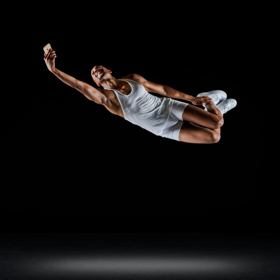Review: Nurturing the Next Generation through Ailey's CHOREOGRAPHY UNLOCKED FESTIVAL

Friday, October 12, 2018 kicked off the first of two weekends of Ailey's Choreography Unlocked Festival featuring an array of panel discussions, conversations, master classes and performances. All programs and events will take place at Ailey's home at The Joan Weill Center for Dance in New York City. As part of the "Ailey Ascending" 60th anniversary year-long celebration, it honors the pioneering legacy of Mr. Alvin Ailey himself and his spirit and belief that "dance came from the people and should always be delivered back to the people."
The Choreography Unlocked Festival builds upon the success of New Directions Choreography Lab- which had its inaugural year in 2011, to create a space for emerging and mid-career choreographers to create dance. Artists are provided support in the form of a monetary stipend, rehearsal space, creative mentorships and access to dancers from The Ailey School. Unlike traditional formats of space grant and/or artist-in-residence programs, the lab does not require the presentation of a final product, which allows the choreographers to focus solely on the creative process- free of time constraints and expectations to produce.
Opening night of the festival included the Choreography Unlocked performance featuring the work of Camille A. Brown, Juel D. Lane and Netta Yerushalmy- alums of the New Directions Choreography Lab.
The program opened with PICTOGRAMS by Netta Yerushalmy. This piece was built around the idea of moving on graph paper as the dancers represented different colors, lines and shapes with a splash of 3-dimensionality. The movements were full of linear pathways and body shapes, as well as curves that could be seen through the jumps and rounded arms. There were a lot of ridged moves, angles, and repetition. There were several points of intersection that could be seen through the crossing of body parts or dancers as well as times of bumping and colliding. I appreciated this unique concept and the cross-curricular connections between dance and mathematics and the political underlying meanings each move represented.
Next was DayDream by Juel D. Lane. This was a dance created specifically to be viewed on film as opposed as a dance that was created on stage that happens to be filmed. With this different lens, the dance has more breadth and dimension. Mr. Lane was inspired by the men in Harlem that he would pass day dreaming. On the outside, it may appear that nothing is happening and that the day is being wasted away. But on the inside, there is so much more going on. His perspective on creating dance for film is to tell the authentic voice and stories of the subject.
Mr. Lane continued with a duet entitled Touch & Agree. This piece was influenced around a previous relationship he was in and using choreography as a form of healing. In the beginning, things were nice, light and happy- very much the honeymoon phase of the relationship. During the second section begins reprise of the dance, but there is a different energy between the two- they are not moving together as they once were. It is as if one has put up a wall as you can feel the conflict and tension build up and the connection unravels. The third section follows the cycle of love where the relationship has ended and needing time space to clear the mind and focus on the self. It's not only important, but vital for one's health.
The evening concluded with a solo by Camille A. Brown performing an excerpt The Real Cool from her 2014 Bessie winning production of Mr. Tol E. RAncE. Dressed like an entertainer from a Minstrel show, she illustrates the internal struggle that many people of color- and in this case specifically African Americans, of feeling invisible and having to hide behind a mask. The mask on the outside shows a smile. But behind the mask, shows the hurt and pain that is often buried or overlooked. Ms. Brown presents the question of will there be a time when "it is possible to live life without a mask?"
The festival continues with its second weekend on October 26-28 including a discussion on Process and Research with leaders of the dance community Dianne McIntyre, Matthew Rushing, Eva Yaa Asantewaa, and Jawole Willa Jo Zollar, moderated by Judy Hussie Taylor.
For more information about upcoming events and performances as part of the festival the 60th anniversary, please visit their website at alvinailey.org.
Photo Credit: Richard Calmes
Videos



